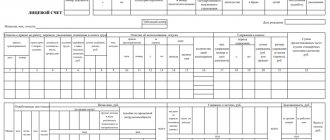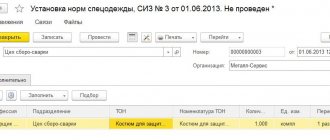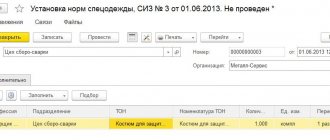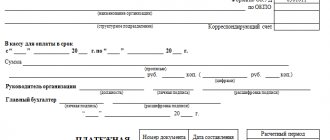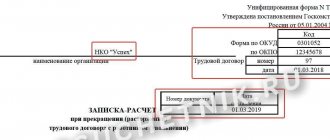First page design
- First of all, on the title page you must indicate the full name of the enterprise (in accordance with the registration documents), as well as the structural unit for which the statement is being drawn up (if there is one).
- Next, you need to enter the code according to the general classification of organizations and the number 70 in the “Corresponding account” column.
- Then the validity period of this statement is indicated, which must be at least 5 days from the moment of its signing (Regulation of the Bank of Russia No. 373-P dated 10/12/2011).
- It is imperative that the total amount accrued to employees for the calculated period be entered in the corresponding line of the first page of the payroll, both in digital and written form.
- After this, you must indicate the date of preparation of the payroll, as well as its serial number according to the internal document flow.
- The last thing that needs to be written on the title page of Form T-53 is the period for which the payment is made. Here you need to indicate specific dates.
Now visually:
General rules of application
Distinctive features of filling out and using are provided for forms T-49 and T-53. This is due to the fact that officials and controllers pay special attention to the correct conduct of cash transactions. These are operations for issuing wages from the cash register.
So, consider the following features:
- Payment amounts are not limited. On payroll days, any amount can be kept in the institution’s cash register, regardless of the approved limit on the cash balance. That is, the surplus does not need to be deposited into a bank account at the end of the working day.
- The salary slip has a limited validity period. The maximum period is set by the company management and cannot be more than 5 days. In simple words, the validity period is the period for which the cashier is obliged to issue salaries to employees. If it is impossible to hand over the money within this period (the employee is sick or on a business trip), then it is returned to the bank. The document makes a special statement.
- Receipt must be confirmed. The employee, having received the money at the cash desk, must recalculate his pay and put his signature in the appropriate column of the statement. It is the signature that confirms that the money has been received. Therefore, the cashier should be careful when filling out the salary slip. If the employee does not sign for the advance payment or salary, then the cashier will be in trouble.
- The issuance of money from the cash register is formalized with one expense cash order. That is, there is no need to form a cash register for each employee. The consumables indicate the total amount of payments. Issuance is carried out on the basis of T-53 or T-49 data. Undistributed money is returned to the cashier from Fr.
- Unreceived or deposited wages can be issued to an employee only on the basis of his written application. Moreover, the issuance is made no later than the next day after the day the application was received.
Filling out the second sheet
The size of the payroll directly depends on the number of employees working at the enterprise - the more there are, the longer this document will be. The number of payroll sheets must be indicated in the appropriate column.
- The first column of the main table of the statement is reserved for the serial numbering of employees.
- The second is for entering a personnel number (this data is stored in the personal cards of the organization’s employees).
- The third contains the full names of the salary recipients (it is better, in order to avoid possible confusion, to do this with a full decoding of the name and patronymic).
- In the fourth column, the enterprise accountant enters the amount of funds accrued for disbursement for each individual person (in numbers).
- In the fifth column, each employee must sign for receipt of wages.
- The sixth column is intended for entering references to documents for cash settlements (this could be powers of attorney, statements from employees, etc.) If there are no separate notes on employees, then this column can be crossed out.
In the line below the table, you must once again indicate in numbers and in words the total amount of funds accrued for issuance
Salary accrual and payment sheet No._________
Organization (division):__________________________________________________________
| № | Full name | Position, degree (title) | Discharge | Bonus (fine) | Amount to be issued | Signature |
Total:_______(__________________________________________) rubles ___ kopecks
Date: "___"_________________ 20___
Download the document “Statement of calculation and payment of wages”
Director's visa on form T-53
Without the signature of the head of the company, the T-53 payroll will not be considered valid, therefore, after filling out all its points and before transferring it to the cashier for issuing wages, the company’s accountant is obliged to submit it to the director for signature.
And one more signature will need to be placed after all funds have been paid to employees. The chief accountant of the enterprise will have to check the payroll and, if there are no violations, also sign it.
Filling out the payroll according to form No. T-51
To fill out the form, you must:
- Fill in the name of the organization and structural unit (accounting).
- Indicate the document number, the date of its preparation and the period covered by the document.
- Fill out the table. The first column indicates the numbers (in order).
- The second column displays employee personnel numbers.
- The third column indicates full name. employees.
- The fourth column reflects the positions of employees.
- The fifth column indicates employee salaries.
- The sixth column reflects the number of days that were worked.
- The seventh column reflects the amount of accruals, including bonuses.
- The eighth column indicates deductions from employees and advance payments.
- The ninth column reflects the amounts owed and the total amount payable.
Corrections in payroll
In general, according to the rules for filling out a payroll form T-53, the cashier, before starting to issue funds on the payroll, is obliged to check whether everything in it is drawn up correctly.
If any errors are found, then this document must be returned to the accounting department for revision.
But sometimes situations arise when, for some reason, it is no longer possible to reissue the payroll. In this case, inaccurate information must be carefully crossed out, the correct information must be written on top, and the correction must be certified by the signatures of all the same employees who signed the initial version of the statement. Here you need to indicate the date of correction. If everything is done in accordance with these recommendations, the document will not lose its legal force.
How to make a statement
The payroll must be prepared by the accounting department, which preliminarily calculates the amount of remuneration for each employee. This responsibility can be assigned to another structural unit at the discretion of the manager.
The salary sheet is prepared according to one of the following forms:
- No. T-49 “Payment sheet”;
- No. T-53 “Payroll”.
Standard forms were approved by State Statistics Committee Resolution No. 1 dated January 5, 2004. Form No. T-49 differs in that it prescribes a detailed calculation of the amount to be issued: the employee’s tariff rate, the number of days or hours worked, accruals by type, amounts of deductions and debts. The payslip only states the amount to be paid to the employee.
Sheet No. T-53
The procedure for filling out the payroll is given in the Instructions. It is compiled in a single copy, but in addition to it, pay slips are required in form No. T-51, in which the salary will be calculated.
Statement No. T-53 consists of a title page, a section with signatures and a tabular part.
On the title page, indicate the name of the organization and the name of the structural unit that compiled the document. Specify the deadline for issuance - according to standards, it does not exceed five working days. Then indicate the total amount to be paid and sign the manager and chief accountant.
In the tabular section, you need to list all employees who should receive money according to the statement. Indicate your personnel number, full name and amount due. In column 5, each employee must sign next to his last name when collecting money.
If the employee does not come for the money on time, the cashier must independently enter “deposited” in column 5.
In the “Note” column, you can indicate passport details or other information by which the cashier identified the employee. This is especially important in large companies where some colleagues do not know each other.
At the end, you need to indicate the total amount issued according to the statement and the deposited part. Additionally, the number and date of the cash register for the issuance of money from the cash register are indicated.
The closed statement is registered in the journal according to form No. T-53a.
Sheet No. T-49
The rules for filling out the payroll statement are given in the same Instructions. It is drawn up in one copy and, unlike Statement No. T-53, is not supplemented by a pay slip, since it initially contains information about calculating the amount to be issued.
The title page is filled out similarly to the T-53 form, but the tabular part is much larger. Let's consider filling it out using the example of April 2022 for two employees.
In column 4, indicate the employee’s tariff rate or salary. In columns 5-7 we indicate the number of days worked. In April there were 21 of them, but senior engineer Anisimov worked 18 days, and technologist Petrov only 10, as he was on vacation. Then in column 8 you should indicate the salary, calculated in proportion to the time worked. If employees received bonuses or other payments, they are indicated in columns 9-13. In our case, both employees received bonuses, and technologist Petrov also received vacation pay. The total amount of income is indicated in column 14.
Columns 15-18 indicate deductions from wages and offset amounts. This is mainly personal income tax and an advance payment for the first half of the month, as well as vacation pay. In column 21, indicate the amount to be paid. Upon receipt, each employee must sign. The cashier may also deposit unpaid amounts if they are not collected on time.
The last page should indicate the total amount of the statement and details of the payment settlement service for the payment of wages.
How to close a payroll
This stage is the final one. After the payroll has expired (five days), the cashier must formalize its closure. Moreover, this must be done even if wages were not issued to all employees. To close the statement you need:
- Write the word “deposited” opposite the names of those employees who did not receive the money due to them according to this statement;
- Count the funds issued and those that were deposited. Enter this information on the last sheet of the statement;
- Confirm the statement with a signature;
- Write out a cash order. In it you need to write the amount of funds issued, then enter the order number in the statement.
After this entire procedure has been completed, the statement must be submitted again to the accounting department.
How to fill out a statement for payment of bonuses using form No. T-49
To fill out the form, you must:
- .
- Fill in the name of the legal entity. person and structural unit that makes the payment (accounting).
- Specify the payment term and amount.
- Provide information about the accountant and the head of the organization.
- Indicate the date the form was completed.
- Display the statement number.
- Reflect the reporting period.
- In the first column of the table, indicate the numbers in order.
- In the second column, reflect the personnel numbers of employees.
- In the third column, indicate the positions of the employees.
- In the fourth column, reflect the salary or other rate for each employee.
- In the fifth column, indicate the number of working days, holidays, and weekends worked.
- In the sixth column, reflect accruals for salary, vacation pay, bonuses, benefits, and other income.
- In the seventh column, indicate the total amount.
- In the eighth column (withheld and offset), indicate the amount of deductions and advances.
- In the “amount” column, indicate the amount of debt and the total amount to be paid.
- In the last two columns please enter your full name. employees and their initials.
The essence and difference between the unified forms T-11a and T-11
Each employer faces situations when it is necessary to reward one of their employees for achievements in their work activities. To do this, it is necessary to draw up and approve an order (instruction) to reward the employee, using the form of organizational and administrative document accepted by the employer. Including, it is possible to compile it using the unified T-11 form, which has ceased to be mandatory for use since 2013, but continues to be used by many employers. At the same time, you should know how to correctly draw up this document and what is the difference between forms T - 11 and T - 11a.
You can download the unified form T-11 on our website. ConsultantPlus experts explained what types of incentives there are and how to arrange them correctly:
If you do not have access to the K+ system, get a trial online access for free.
Orders on unified forms T-11 and T-11a are distinguished by the fact that in form T-11 an order will be given to reward only 1 employee, and form T-11a is used to reward several employees.
The unified form T-11a can also be downloaded on our website.
